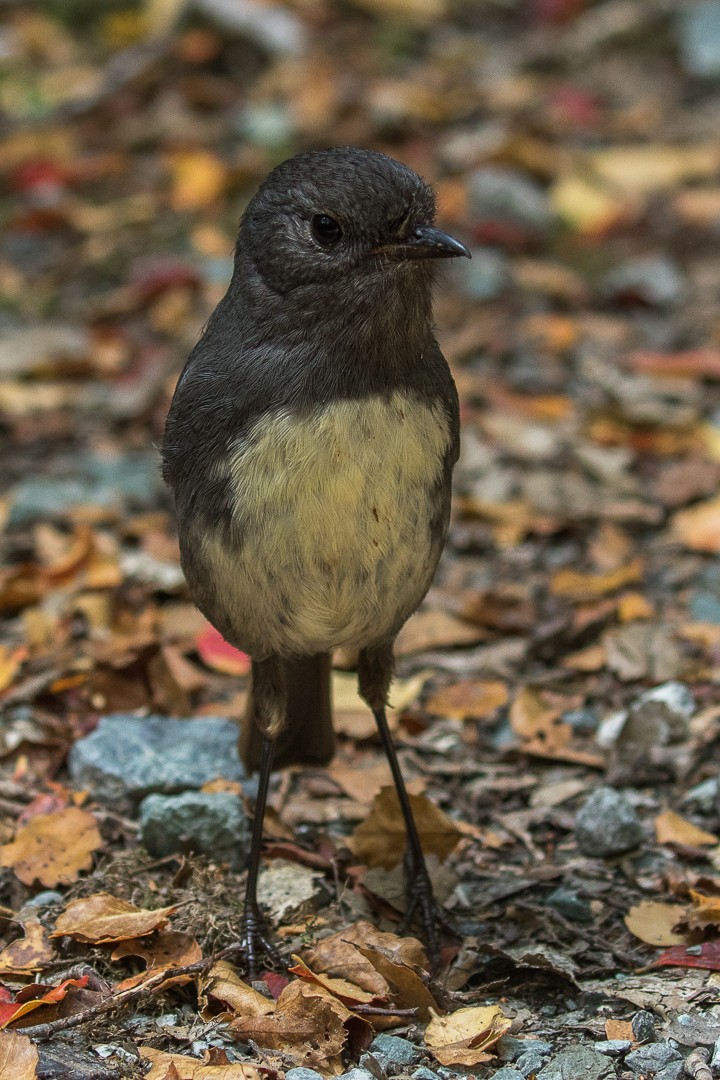South Island Robin
A species of Australian Red Robins and Allies, Also known as Toutouwai Scientific name : Petroica australis Genus : Australian Red Robins and Allies
South Island Robin, A species of Australian Red Robins and Allies
Also known as:
Toutouwai
Botanical name: Petroica australis
Genus: Australian Red Robins and Allies
Content
Description General Info
 Photo By Francesco Veronesi , used under CC-BY-SA-2.0 /Cropped and compressed from original
Photo By Francesco Veronesi , used under CC-BY-SA-2.0 /Cropped and compressed from original Description
The South Island robin is a small passerine, 10–18 cm in length and weighing around 35 g. North Island robins do resemble both females and juveniles of the South Island robins, as well as all the Stewart Island robins, which can sometimes make it difficult to distinguish between the three. The females and juveniles within a particular group of robins look similar to each other, although newly independent juveniles may not yet have the more lightly coloured breast patch. However, male North Island robins are almost black with a white spot just above the beak, as well as the greyish-white lower breast. Females and juveniles are greyer with more variable pale patches on their breasts and throats. Male South Island robins are dark grey, except for the distinct yellowish-white lower chest, while females and juveniles are again lighter grey with a less distinct breast. Finally, Stewart Island robins look similar to North Island robins (both males and females). New Zealand robins are relatively long-lived; life-spans of at least 14 years have been recorded in the wild. 
Size
18 cm
Nest Placement
Cavity
Feeding Habits
South Island Robin feasts primarily on invertebrates, earthworms, and beetles, with seasonal preferences for earthworms in winter and cicadas in summer. South Island Robin uses a unique caching strategy, storing prey in multiple locations with remarkable memory, even beyond its territory. Occasionally consuming berries, south Island Robin allocates much of the day to foraging, especially in winter.
Habitat
South Island Robin favors a variety of wooded environments, particularly those dominated by native manuka and kanuka scrub, Nothofagus–podocarp forests, and mature Douglas fir forests. It is sometimes found in residential gardens in the southern regions and open grazing areas with adequate cover. South Island Robin usually inhabits gulleys or ridgetops and avoids areas with mature Monterey pine stands. Its preference is for lowland to subalpine forest zones.
Dite type
Insectivorous
General Info
Feeding Habits
Bird food type
Distribution Area
Historically, the South Island robin inhabited much of the lowland of New Zealand's South Island, but its distribution has become much more patchy in the last century due to habitat loss and introduced predation. There are two populations on the east coast of the South Island, and they are slightly more common in the north and west. It has fared slightly better than the Stewart Island robin, which has been relegated to 3 subpopulations, all of which are in Leptospermum swamp scrubland—although this is not their preferred habitat, it is less heavily populated by mammalian predators. Total population was lower than 500 individuals at one point. A programme of translocation to predator-free islands (such as Ulva Island, Motuara Island, and Nukuwaiata Island) was instituted and proved relatively successful at establishing new populations (around 600 individuals on Motuara alone). In the South Island, P. australis has a strong affinity for Douglas fir plantations, instead of the native forests (kanuka trees) or Monterey pine plantations. This is apparently due to forest structure rather than strict food availability or viable nesting sites, as the species prefers structurally simple forests with dense, even canopies, and ground covered with leaf litter. When the population was introduced to Ulva Island, nesting was positively correlated with the presence of broad-leaved coastal vegetation. 
Species Status
The South Island robin is listed as being of least concern on the IUCN Red List. However, the Stewart Island robin (Petroica australis rakiura) has gone through a couple of bottlenecked populations recently because of deforestation and habitat loss, as well as introduced predators, such as rats, stoats, and feral cats. Because of this sharp decline in the Stewart Island population, several attempts have been made to translocate the Stewart Island robin to other islands nearby where introduced predators do not exist or have been eradicated (see above). However, many of these translocations have involved 12 or fewer colonising individuals, making inbreeding nearly unavoidable. This has led to some apparent immunocompetency issues as well as reproduction problems. On Motuara Island, high rates of hatching failure as well as fewer clutches were observed. Inbreeding and its genetic and immunological consequences, therefore, remain a concern with this subspecies. In contrast, birds in the South Island do not show much genetic loss in comparison with historical populations, although their distribution on the island has become increasingly fragmented. 
Scientific Classification
Phylum
Chordates Class
Birds Order
Perching birds Family
Australasian robins Species
South Island Robin